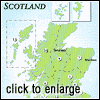|
Dingwall and Around
The area inland from the Black Isle is popular holiday
country, again established by the Victorian trend for the Highlands. Dingwall is
a main centre with plenty of shops and supermarkets to stock up for more remote adventures.
Macbeth was born here. The Town House is worth stopping for the museum, mostly dedicated
to a local soldier made good, General Sir Hector MacDonald.
 The village of Strathpeffer is due east of Dingwall, a popular
spa town in the 1800s and remaining a quiet resort with plenty of hotels. Walking
is a popular pastime in this area with the Eagle Stone, a Pictish symbol stone, found
just east of the village, being one of the most frequented. The village of Strathpeffer is due east of Dingwall, a popular
spa town in the 1800s and remaining a quiet resort with plenty of hotels. Walking
is a popular pastime in this area with the Eagle Stone, a Pictish symbol stone, found
just east of the village, being one of the most frequented.
It was predicted by the Brahan Seer that if the stone
fell from its perch three times, then ships would tie up to it. It has already toppled
twice and the Cromarty Firth flooded up to Dingwall's county buildings. Perhaps the
clairvoyant foresaw the results of global warming. Today the stone is firmly cemented
to its base.
Further south are the villages of Conon Bridge, Muir
of Ord and Beauly. The Black Isle Show is held just outside Muir of Ord in August
of each year.
Beauly is a genteel little place with the ruins of
a thirteenth century priory and a world famous and long established wool and tweed
shop, Campbell's. It is also an established centre for salmon and brown trout fishing.
Beats on the River Beauly are quite expensive for salmon but much less expensive
brown trout fishing is available around the town of Beauly itself. Permits can be
had from Beauly Angling Club.
 Beauly Music Festival is held late in September and features
a variety of bands from around Britain. The Priory Restaurant & Hotel is a little
expensive but worth the extra for the quality of cuisine and service. Beauly Music Festival is held late in September and features
a variety of bands from around Britain. The Priory Restaurant & Hotel is a little
expensive but worth the extra for the quality of cuisine and service.
There are interesting excursions away from Beauly
into some of Scotland's most spectacular glens. Following the B831 south-west, Glen
Affric is one of the most untamed, wild chunks of Highland country still in existence.
Its hills are the highest in Scotland north of the Great Glen. Being quite remote,
you are more likely to see a red deer here than a fellow human. Glencannich lies
north above Loch Affric where a Hydro Electric dam has turned two lochs into one,
at 9 miles (14km) long, the biggest in Scotland.
|


